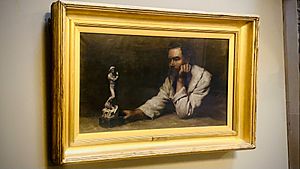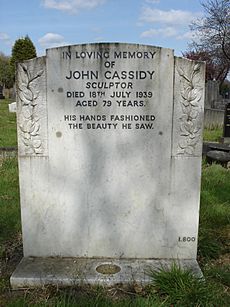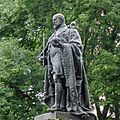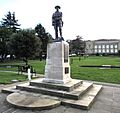John Cassidy (artist) facts for kids
Quick facts for kids
John Cassidy
|
|
|---|---|

1899 photograph of John Cassidy
|
|
| Born | January 1, 1860 |
| Died | July 19, 1939 (aged 79) St Joseph's Hospital, Whalley Range, Manchester
|
| Resting place | Southern Cemetery, Manchester |
| Nationality | Irish |
| Alma mater | Manchester School of Art |
| Known for | Statue of Edward Colston |
| Movement | New Sculpture |
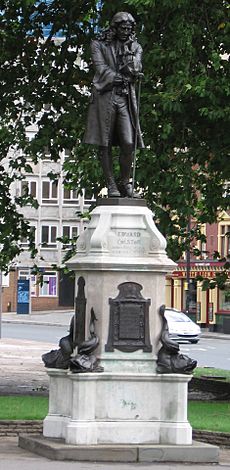
John Cassidy (born January 1, 1860 – died July 19, 1939) was a talented Irish sculptor and painter. He spent most of his life working in Manchester, England. John Cassidy created many famous public statues and memorials that you can still see today.
Contents
About John Cassidy
John Cassidy was born in a small place called Littlewood Commons in County Meath, Ireland. This was on January 1, 1860. When he was 20, he moved to Dublin to find work.
While in Dublin, he took art classes at night. He was so good that he won a special scholarship. This allowed him to study art in Milan, Italy. After two years, he moved to Manchester, England. He lived there for the rest of his life. He even studied and later taught at the Manchester School of Art.
John Cassidy became well-known for his public sculptures. Many of these were war memorials. He showed his art in important galleries. These included the Royal Academy and the Manchester City Art Gallery.
Famous Sculptures
John Cassidy made many statues and memorials. These artworks are still enjoyed by people today.
The Rylands Library Statues
In 1894, a kind lady named Enriqueta Rylands asked Cassidy to create a statue. It was of her late husband, John Rylands, who made textiles. This statue was placed in the reading room of the John Rylands Library in Manchester. Enriqueta founded this library to honor her husband.
Later, people who supported the library asked Cassidy to sculpt Enriqueta herself. This statue was shown in 1907. Both statues are still in the library today. They stand at each end of the main reading room. Inside the library, there is also a group of three figures. They represent "Theology inspiring Science and Art."
The Jubilee Fountain
In 1896, the city of Manchester asked Cassidy to design a large fountain. It was for Albert Square, Manchester. This fountain celebrated Queen Victoria's 60 years as queen. This event is called her Diamond Jubilee.
The beautiful hexagonal fountain stood in the square for many years. In the 1920s, it was moved to Heaton Park. But in 1997, during renovations, the fountain was brought back. It now stands in its original spot in Albert Square.
Adrift Sculpture
Another famous work in Manchester is a bronze sculpture from 1907. It is called Adrift. This artwork shows a family holding onto a raft in a stormy sea. It shows the style of the New Sculpture movement.
A rich art collector named James Gresham gave Adrift to Manchester. It became the main artwork in the new Piccadilly Gardens around 1930. Later, in 1953, it was moved again. Today, Adrift stands in front of the Manchester Central Library. You can find it in St Peter's Square, Manchester.
The Edward Colston Statue
In 1895, Cassidy was asked to create a public monument for Bristol. This was a statue of a merchant named Edward Colston. It was put up to celebrate his good deeds. However, Edward Colston was also involved in the Atlantic slave trade. This part of his history became very controversial.
On June 7, 2020, during a protest, the Colston statue was pulled down. Protestors pushed it into Bristol Harbour. From June 2021, the damaged statue was shown at the M Shed museum in Bristol.
Many of John Cassidy's works are still in the Manchester area. Other smaller pieces are in private collections.
Other Notable Works
John Cassidy created many other important sculptures. Some of these include:
- Adrift, Manchester
- Clayton-le-Moors war memorial
- Duthie Monument, Duthie Park, Aberdeen
- John Kay memorial, Bury, Greater Manchester
- Jubilee Fountain, Albert Square, Manchester
- Sir Benjamin Alfred Dobson statue, Bolton
- Statue of Edward Colston, Bristol
- Statue of Edward VII, Manchester
- Statue of Enriqueta Rylands, John Rylands Library, Manchester
- Statue of John Rylands, John Rylands Library, Manchester
- Bust of Harry Houdini
After World War I, Cassidy made many war memorials. These were for towns across Britain. Some of these towns include Eccles, Heaton Chapel/Heaton Moor, Skipton, Stourbridge, and Colwyn Bay.
Later Life and Legacy
Towards the end of his life, John Cassidy lived in Fallowfield, Manchester. He became ill and was taken to St Joseph's Hospital. Even in the hospital, Cassidy kept sculpting. He was working on a bust of Pope Pius XII when he passed away. This was on July 19, 1939, when he was 79 years old.
He was buried in the Roman Catholic part of Manchester's Southern Cemetery. His gravestone has a special message: "His hands fashioned the beauty he saw." Many of his public sculptures are still on display today. They can be seen in towns and cities all over the United Kingdom. A portrait of John Cassidy from 1900 is kept at the Manchester Art Gallery.
Images for kids
-
Statue of Enriqueta Rylands (detail), John Rylands Library, Manchester


